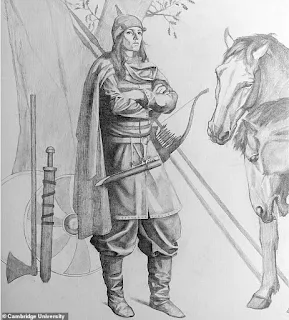Important archaeological discoveries continue to reveal their secrets over time, and using modern means, and this is what happened to the grave of a “great” Viking warrior found in the town of Birka, Sweden, in 1878.
The tomb dates back to the tenth century AD and was found in an underground room. The warrior was buried in a sitting position with two horses, in addition to an arsenal of ancient weapons consisting of a sword, axe, knives, spears, shields and arrows.
A game board with 28 dice-like pieces made of antler was also found at this burial site, which was assumed to be used in drawing military plans, leading scientists to believe that the remains belong to a major Viking military leader. It is a term given to fierce fighters and skilled sailors who lived in the Scandinavian regions, which include Sweden, Denmark, Norway, and Iceland. They launched raids on parts of Europe, especially the British and French coasts, between the eighth and eleventh centuries.
The tomb of this warrior became important because it was one of two out of 1,100 similar tombs found in the Birka cemetery, which included a complete collection of weapons.
The grave also gains importance because it is located in the west of the Swedish town of Birka, in a location visible from the sea and land. The site is distinguished by a large stone boulder, which is supposed to identify the owner of the grave as a high-ranking leader within his community.
The settlement of Birka, located on the island of Björk in the eastern part of central Sweden, is described as the first civilizational center in the region, and it was a major commercial center between the 8th and 10th centuries.
The belief that the grave belonged to a major Viking professional warrior was supported by the presence of a large number of weapons and two horses, in addition to the absence of any agricultural tools or the like. Experts suggested that the warrior was likely to be a famous knight of his time and an archer.
This belief remained for more than 125 years, but a surprise occurred in 1970, when the bones of the grave were analyzed. Analysis showed that the skeleton of this "warrior", which is characterized by a slender build, belongs to a woman, not a man.
Doubt remained until conclusive evidence emerged in 2017. Then the results of a DNA analysis of the warrior’s remains were published, confirming that the remains of the nearly 1,000-year-old warrior who owned an arsenal of weapons and combat planning tools belonged to a woman, estimated to be over thirty years old.
Immediately, widespread controversy arose in the relevant scientific community after these results appeared. Although finding weapons in the graves of Viking women was common, some experts criticized what was announced regarding this distinctive grave, doubting that those conducting the DNA analysis had analyzed the correct bones, pointing to the possibility that a woman was buried with the warrior, While some pointed out the possibility that the grave might be that of a “transsexual.”
Regarding the possibility that the grave belongs to a transgender person, the authors of the study responded by saying that this is a modern Western political and intellectual term and does not apply to an ancient society, stressing that all the bones found inside the tomb “PG 581” belong to one woman, and they are identical to the notes and drawings made by the discoverer. The grave in 1878.
Genetic study experts confirmed that “the most clear and logical conclusion” is that the owner of that grave was a woman who lived as a professional warrior and was buried according to this status.
The opponents may continue to cling to their opinions, but the warrior in the grave of the Sudanese town of Birka, as accurate scientific analyzes confirm, is a woman who fought against men on the battlefield and was buried with the reverence that warriors deserve.


Brilliant 😊
ReplyDeleteGood
ReplyDeleteGood
ReplyDeleteThe tomb dates back to the tenth century AD and was found in an underground room. The warrior was buried in a sitting position with two horses, in addition to an arsenal of ancient weapons consisting of a sword, axe, knives, spears, shields and arrows.
ReplyDelete